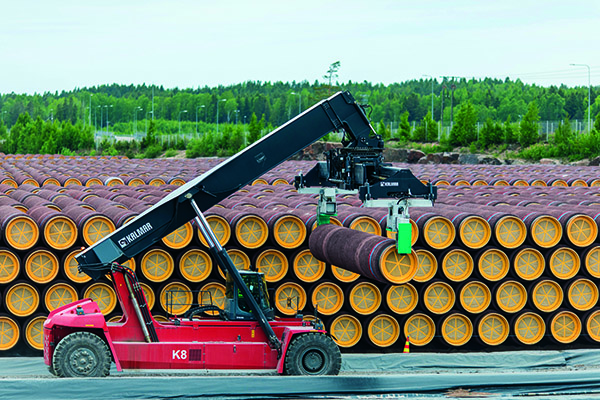Nord Stream Turbine Tension Puts Focus on Gas Pipeline Parts
(Reuters) — Tension over giant turbines that Moscow blames for the reduction of flows via the Nord Stream 1 gas pipeline has put the focus on the equipment it needs to operate.
The crucial part is SGT-A65, a Siemens Energy turbine that is 12 meters long, weighs 20 tonnes, and needs to be transported back to Gazprom's Nord Stream Portovaya compressor station following maintenance in July.
It is stuck in transit in Germany, with Russia pointing to outstanding issues around its transport and Western sanctions, while Germany blames Moscow for deliberately holding up the process.
On Friday, Gazprom announced a three-day shutdown of Nord Stream 1 from Aug. 31 to Sept. 2 because the only remaining gas compressor running at Portovaya requires maintenance.
It had already stopped gas supplies via the route for 10 days for annual maintenance last month, resuming the flows at lower-than-normal levels on July 21.
What's The Problem?
President Vladimir Putin says the West has unleashed an economic war aimed at destroying Russia and its economy, and has promised to sell Russia's vast energy resources to countries in Asia, such as China, if European customers do not want to buy them.
Kremlin-controlled Gazprom has reduced flows through Nord Stream 1, the single biggest pipeline carrying Russian gas to Germany, to 20% of capacity because of what it describes as faulty equipment, notably the SGT-A65 turbine whose return has been delayed.
The St. Petersburg-based company has said Canadian, EU and UK sanctions make delivery of the Siemens turbine to the Portovaya compressor station impossible.
Germany has said the turbine is a pretext, and that Moscow is using gas as a political weapon. "They don't even have the guts to say 'we are in an economic war with you'," German Economy Minister Robert Habeck said last month.
Gazprom has also halted another Siemens Energy gas turbine at the station, citing routine maintenance and the "technical condition" of the engine. Currently, only one turbine is in operation.
Turbines And Compressors
Eight industrial aeroderivative gas turbines were originally manufactured by Rolls-Royce for the Portovaya station. Rolls-Royce's gas turbine-making operations were bought by Siemens Energy in 2014.
These turbines are needed to power driving centrifugal compressors, which raise pressure by condensing gas volumes to ensure smooth transport of the fuel.
Rystad Energy analyst Lu Ming Pang said the units require maintenance after 34 months of operation.
"Like the maintenance from 12 July to 21 July, market participants are wary of the possibility that the flows may not return on schedule, if at all," he said.
According to Gazprom, six of the gas pumping units at Portovaya have a capacity of 52 megawatts (MW) each, while two units have a capacity of 27 MW each.
In addition, there are four spare turbines on site to ensure the station keeps pumping if some equipment has to leave the site for maintenance, which usually happens every two-to-three years, a person familiar with the matter said.
Two of the six large units may stay idle without reducing the station's capacity, a source familiar with how the station operates said.
Gazprom has not replied to questions about Nord Stream 1 operations.
"Understandably, a lot of people are saying 'this is just the Russians making excuses while they put pressure on the European energy market'," Jonathan Stern, Distinguished Fellow at the Oxford Institute for Energy Studies, said.
"That is entirely possible because we just don't know enough from either Siemens or Gazprom about the maintenance schedule. The problem is that neither side is giving us the information we need."
What's Portovaya?
The Portovaya compressor station is located near the Russian city of Vyborg on the shores of the Gulf of Finland, where the Nord Stream 1 gas pipeline enters the Baltic Sea.
The station pumps natural gas across the Baltic Sea via Nord Stream 1's 1,224 km (760 mile) undersea route to where it makes landfall in Germany's Greifswald. Gazprom calls Portovaya the world's largest compressor station.
Nord Stream 1 has a nameplate capacity of 55 billion cubic meters (Bcm) per year. However, the pipeline pumped more than 59 Bcm in 2020 and 2021 after measures were taken to raise capacity, representing more than a third of Russia's total gas supply to the European Union.
Portovaya reached a daily record of almost 177 million cubic meters per day in 2020.
Russian Turbines
Russia produces turbines with a maximum capacity of 25 MW.
Engineering company Power Machines is developing two types of turbine with capacities of 65 MW and 170 MW each, it said.
The 65 MW turbine is expected to start working in testing mode only in 2024, and the other later in 2022 or in 2023.
Russian Industry and Trade Minister Denis Manturov said in a speech last month in parliament that Russia was speeding up trials of the large turbines "in the interests of the Russian power sector".
Related News
Related News

- Keystone Oil Pipeline Resumes Operations After Temporary Shutdown
- Biden Administration Buys Oil for Emergency Reserve Above Target Price
- Freeport LNG Plant Runs Near Zero Consumption for Fifth Day
- Enbridge to Invest $500 Million in Pipeline Assets, Including Expansion of 850-Mile Gray Oak Pipeline
- Williams Delays Louisiana Pipeline Project Amid Dispute with Competitor Energy Transfer
- Evacuation Technologies to Reduce Methane Releases During Pigging
- Editor’s Notebook: Nord Stream’s $20 Billion Question
- Enbridge Receives Approval to Begin Service on Louisiana Venice Gas Pipeline Project
- Russian LNG Unfazed By U.S. Sanctions
- Biden Administration Buys Oil for Emergency Reserve Above Target Price





Comments